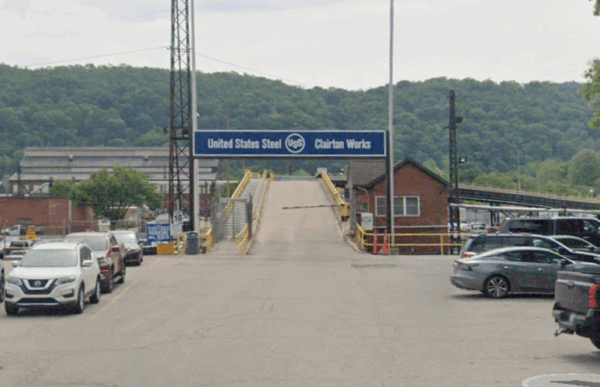
An explosion at the U.S. Steel Clairton Coke Works, located at 1 Camp Hollow Rd, West Mifflin, PA 15122, on Monday resulted in the deaths of two workers and injuries to ten others. According to The Allegheny Front, the incident adds to a troubling history of accidents, environmental violations, and equipment failures at the plant, which is located about 15 miles south of Pittsburgh.
The Clairton Coke Works is a key facility in steel production, baking 4.3 million tons of coke annually. Coke, created by heating coal at extreme temperatures, is a critical element in the steelmaking process. The plant’s operations rely on coke oven gas, a highly flammable byproduct, as a fuel source. The ovens, organized into batteries, reach temperatures exceeding 2,000°F during the production process.
The Clairton plant has faced multiple safety concerns over the years. Past incidents include a 2009 explosion that killed a worker, a 2010 explosion that injured 20, and a 2014 fatal fall. In February of this year, another explosion sent two workers to the hospital, while a separate malfunction in June disrupted pollution controls.
Investigations have highlighted systemic issues, with a 2018 fire exposing the extent of equipment neglect. That fire led to a spike in sulfur air pollution, increasing by 4,500% over three months and exacerbating asthma cases in the surrounding area. Former Allegheny County Health Department official Jim Kelly described the facility as "decrepit," citing widespread corrosion, rust, and outdated equipment.
Beyond safety concerns, the Clairton Coke Works has been a persistent violator of air quality regulations. The Allegheny County Health Department has levied $56 million in fines against the plant since 2022, including $42 million for the damage caused by the 2018 fire. The plant has been in violation of the Clean Air Act for 12 consecutive quarters, according to the EPA, and remains the largest single source of air pollution in Allegheny County.
Recent fines have focused on batteries 13 and 14, the site of Monday’s explosion. Environmental groups argue that the plant’s ongoing failures demand urgent corrective action, particularly given its impact on local air quality.
At a press conference on Tuesday, U.S. Steel officials confirmed that the plant was operating normally prior to the explosion. The company has launched an investigation into the incident. U.S. Steel’s new owner, Japan-based Nippon Steel, has pledged $2.4 billion in investments across the Mon Valley Works, including the Clairton facility. Local advocates believe this funding provides an opportunity to address longstanding safety and environmental issues.
For now, the community surrounding the Clairton Coke Works faces lingering questions about accountability, safety, and the plant’s impact on their health and environment.

Factory explosions not only leave behind physical and emotional devastation but also raise important questions about accountability and safety standards. In the aftermath of the Clairton Coke Works explosion, which claimed two lives and injured ten others, we spoke with experienced work injury lawyer Guy D’Andrea to explore the legal options available to injured workers and the families of those who have lost their lives. D’Andrea provides valuable information on how victims can navigate compensation claims and hold negligent parties responsible.
Darla Medina (Editor): Incidents like the one at Clairton Coke Works raise questions about workplace safety. What legal avenues are available for injured workers or the families of those who lost their lives?
Guy D’Andrea (Work Injury Lawyer): These cases often involve multiple layers of accountability. Injured workers or their families can typically file for workers’ compensation, which provides benefits without needing to prove fault. However, if negligence or faulty equipment played a role — and that negligence goes beyond the employer’s responsibility — civil lawsuits can also be pursued against third parties, such as equipment manufacturers or contractors.
Medina: Given Clairton’s history of violations and equipment failures, would this history influence legal action?
D’Andrea: Absolutely. A documented history of safety violations and equipment neglect can strengthen a case by showing a pattern of disregard for worker safety. It could potentially lead to punitive damages, which are designed to penalize and deter such negligence.
Medina: Are there specific challenges victims face when taking legal action in these cases?
D’Andrea: One challenge is navigating complex industry regulations and proving that a company’s actions—or inactions—directly caused harm. Large corporations often have legal teams ready to defend against such claims, so victims need experienced legal representation to level the playing field.
Medina: What advice would you give to those affected by this explosion?
D’Andrea: I’d recommend documenting everything—medical records, workplace conditions, and communication with the employer. Consulting a lawyer as soon as possible is critical to understanding all available options. Time limits for filing claims can be strict, and acting quickly is often the key to achieving justice.
If you or a loved one has been impacted by a factory explosion or workplace accident, don’t wait to explore your legal options. Time is a critical factor in securing compensation and holding responsible parties accountable. Contact us today for a free, no-obligation consultation to discuss your case and understand the steps you can take to achieve justice. We’re here to fight for you.
 info@legalherald.com
info@legalherald.com